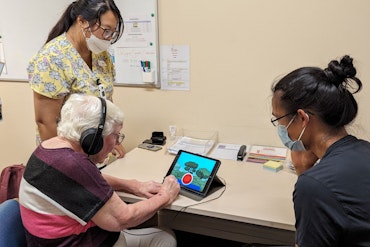Artificial intelligence used to predict Parkinson’s disease
Today, researchers published their findings on the tool, which uses neural networks to pick up on signs of the disease in patients’ bodily fluids and detect early onset before symptoms appear.

Parkinson’s disease could now be detected up to 15 years before symptoms appeared if a new machine-learning tool from the University of New South Wales (UNSW) is validated. (Source: Shutterstock)
Key points:
- Physical symptoms such as a resting hand tremor are used to diagnose Parkinson’s disease
- Researchers are hoping that symptoms such as sleep disorder or apathy can be used to identify the non-genetic onset
- Results show that the CRANK-MS tool has been able to predict Parkinson’s disease with 96 percent accuracy, but Associate Professor Donald is still keen for further studies around the globe
Currently, there is no blood test which can identify non-genetic risk of Parkinson’s disease, but through collaborating with Boston University, scientists from UNSW have developed a new tool which could be a game changer.
Today, researchers published their findings on the tool, which uses neural networks to pick up on signs of the disease in patients’ bodily fluids and detect early onset before symptoms appear.
Parkinson’s primarily affects older people, with symptoms before the age of 50 classified as ‘young-onset,’ with average onset typically increasing after the age of 60.
Researchers from the UNSW School of Chemistry looked at blood samples from individuals and paired that against 39 patients who developed the disease up to 15 years later. Their new tool ran through sets of data which looked at how they were able to metabolise things going into their body such as food, drugs or chemicals, giving them a unique insight into certain predictors.
The tool is called CRANK-MS, which stands for classification and ranking analysis using neural network generates knowledge from mass spectrometry, developed by UNSW researcher Diana Zhang and Associate Professor W. Alexander Donald.
“The most common method of analysing metabolomics data is through statistical approaches,” says Ms Zhang.
“So to figure out which metabolites are more significant for the disease versus control groups, researchers usually look at correlations involving specific molecules. […] Here we take into account that metabolites can have associations with other metabolites – which is where machine learning comes in. With hundreds to thousands of metabolites, we’ve used computational power to understand what’s going on.”
Dr Donald says that in addition to looking at combinations of metabolites, the researchers used an unedited list of data.
“Typically, researchers using machine learning to examine correlations between metabolites and disease reduce the number of chemical features first, before they feed it into the algorithm,” he says.
“Here, we feed all the information into CRANK-MS without any data reduction right at the start. From that, we can get the model prediction and identify which metabolites are driving the prediction the most, all in one step. It means that if there are metabolites which may potentially have been missed using conventional approaches, we can now pick those up.”
CRANK-MS is publicly available to any researchers who would like to use machine-learning for disease diagnosis, with the hope to monitor other diseases in a similar way.
“The application of CRANK-MS to detect Parkinson’s disease is just one example of how AI can improve the way we diagnose and monitor diseases. What’s exciting is that CRANK-MS can be readily applied to other diseases to identify new biomarkers of interest,” says Ms Zhang.
“The tool is user-friendly where on average, results can be generated in less than 10 minutes on a conventional laptop.”























